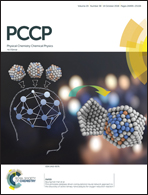Theoretical and experimental investigations of 129Xe NMR chemical shift isotherms in metal–organic frameworks†
Abstract
The pressure dependence of the 129Xe chemical shift in the metal–organic frameworks (MOFs) UiO-66 and UiO-67 (UiO – University of Oslo) has been investigated using both theory and experiment. The resulting chemical shift isotherms were analyzed with a theoretical approach based on model systems (as proposed by K. Trepte, J. Schaber, S. Schwalbe, F. Drache, I. Senkovska, S. Kaskel, J. Kortus, E. Brunner and G. Seifert, Phys. Chem. Chem. Phys., 2017, 19, 10020–10027) and experimental 129Xe NMR measurements at different pressures. All investigations were carried out at T = 237 K while the pressure range was chosen according to the maximum pressure at which Xe liquifies (p0 = 1.73 MPa or 17.3 bar), thus 0 < p ≤ p0. The theoretically predicted chemical shift isotherms agree well with the experimental ones. Additionally, a comparison of the chemical shift isotherms with volumetric adsorption isotherms was carried out to determine the similarities and differences of both isotherms.



 Please wait while we load your content...
Please wait while we load your content...